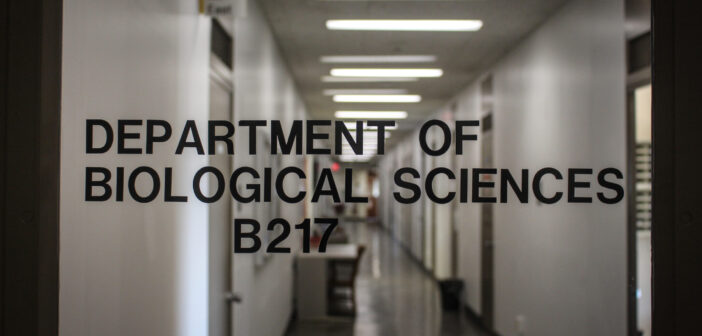After spending their pandemic time completing neuroscience research, associate professor of biological sciences Julie Haas and third-year graduate student Austin Mendoza recently published their research exploring the significance of asymmetric connections between neurons.
Mendoza’s research studies the subfield of neuroplasticity, or the ability for connections of the brain to change. The research completed with Haas is his first publication.
Mendoza explained that his research involved the electrical connections between cells in the brain; the movement of electricity acts as a form of cell-to-cell messaging.
“We started looking at some basic properties of electrical synapse transmission that weren’t really fully explained in the literature,” Mendoza said. “We wanted to look into this property of asymmetry and try to understand the different factors that may contribute to it.”
The physical components of neurons such as dendrites and synapses can vary in size, distribution and distance between other neurons in the brain.
While it has been widely expected throughout biological neuroscience that neuron connections are symmetrical and act accordingly, Mendoza and Haas found that these different properties can cause the electrical messaging to flow unevenly.
“You’ll be surprised as to what fields have their own little controversies. That’s some of the most exciting areas of science, because that’s the back and forth — there’s evidence published for and against it, and that’s a major part of the scientific process,” said Mitch Vaugn, a doctoral candidate in their biological neuroscience lab. “No one outside the field would know that there’s controversy about the asymmetry of electrical synapses and mammalian brains, but it is really interesting to find those contentious points and see what the experts are saying.”
This uncovered asymmetry can ultimately affect larger brain functions in varying ways: micro differences in the brain can cause macro behavioral changes.
“If someone knocks on the door in the basement and you’re not very responsive, it might seem like that input was weak, but it might be because you’re asleep. But it could also be that you’re a very over-sensitive person and you’re screaming every time someone knocks anywhere — you’re over responsive to those inputs,” Haas said. “Is it a weak input coming from far away? Is it a strong input coming very close? Are you too responsive? Or are you one of those people who just kind of isn’t? These are the types of differences we characterized.”
Haas and Mendoza share the belief that researchers must identify, address and fill gaps in knowledge when it comes to their field. Specifically, they did this through the use of theoretical model simulations and coding.
Because of the pandemic, a majority of Haas and Mendoza’s research was done via computer.
“They went through simulating this, creating model neurons, tweaking factors,” Vaughn said. “I think a really amazing figure in there is that they showed that during an experiment, you could measure asymmetry.”
After months of laborious research, Haas and Mendoza found that preparing their findings for publishing took up a majority of their time. As scientists, Haas said that the research sometimes seems straightforward compared to writing, refining and editing a digestible translation of their findings, which takes a great deal of time.
Haas believes their research has the potential to improve understanding of how the brain functions from the cells to the brain systems, especially when paired with research being done in the same or similar fields.
“If you’re making a computational model of a network or a neuron, you should probably think about including this level of detail (we’re researching), because it turns out it makes a difference,” Haas said.
She believes advancement in scientific research comes from individual drive, and both she and Mendoza urge students to pursue what drives them.
“Science moves forward as a sum of a whole bunch of people’s individual interests, so it’s in everyone’s benefit for science to gather as many unique, diverse interests as you can possibly get. Then we come together to get a better understanding of the brain,” Haas said.






Comment policy
Comments posted to The Brown and White website are reviewed by a moderator before being approved. Incendiary speech or harassing language, including comments targeted at individuals, may be deemed unacceptable and not published. Spam and other soliciting will also be declined.
The Brown and White also reserves the right to not publish entirely anonymous comments.
1 Comment
Good work and interesting,